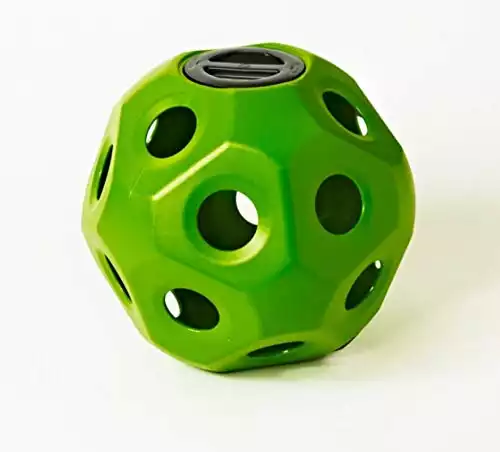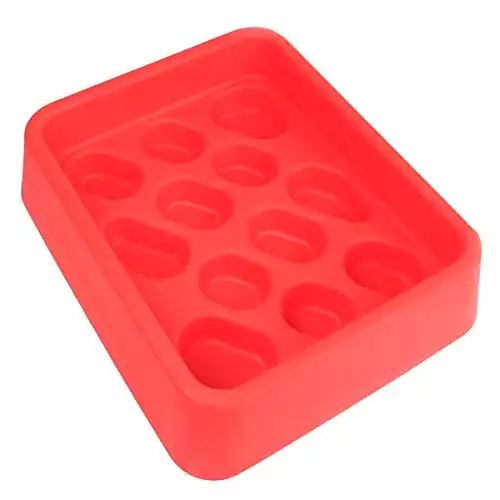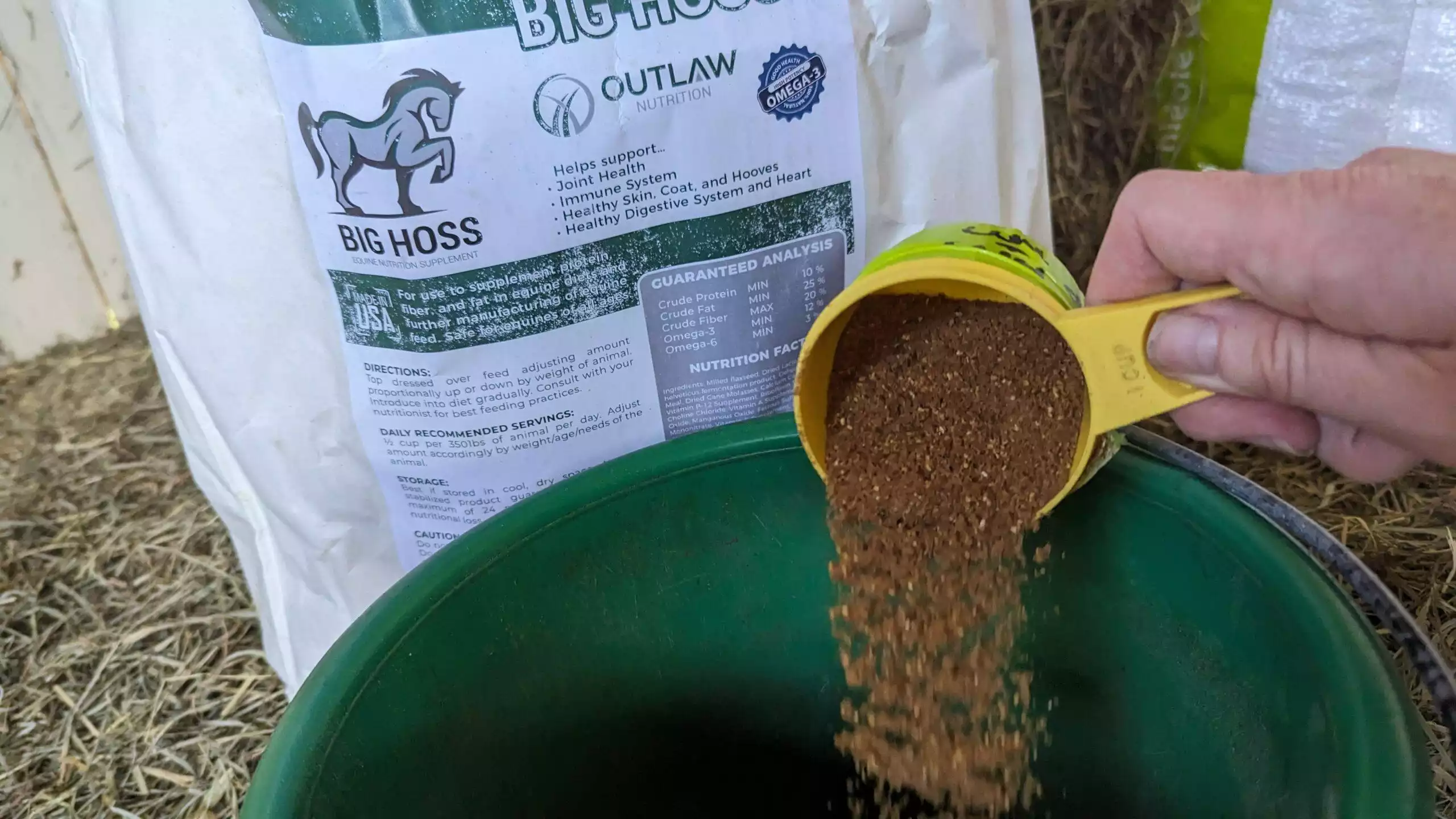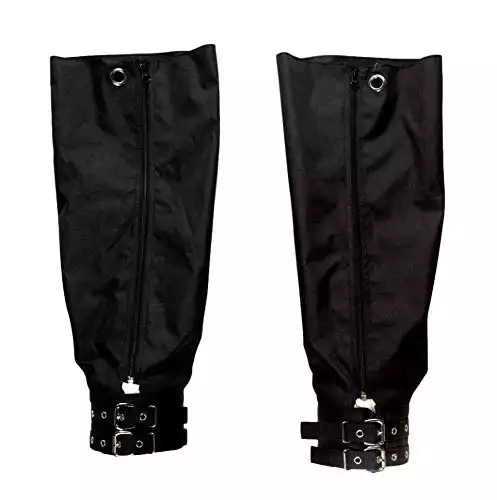Does your horse need a grazing muzzle in the winter?
It’s never a straightforward answer with horses! Most of us might associate a muzzle with overweight horses. There are a few more reasons to use grazing muzzles in winter, specifically how wacky winter pasture can be.
Jump to video and shopping

Reasons to use a grazing muzzle
- You rarely hear a horseperson saying that their horse eats slowly. RARELY. And when it comes to pasture, there are vital things to know.
- One – grasses have varying amounts of sugars and starches in them. Sugar levels depend on the type of grass, the season, the weather and temperature, how tall it is, and more. Sugar levels are a moving target!
- Two – these starches and sugars in the grass, when devoured rapidly, land in the stomach and quickly pass through the digestive tract. In the hindgut, bacteria and microbes have a literal PARTY and will chow down and pump out gas, endotoxins. This “bacteria poop” is what leads to colic and laminitis. Slow this influx of grass down by using muzzles.
- Three – horses are masters of knowing a routine. If they know they will be out 24/7, there’s no rush to inhale pasture. If they know they have limited time, they will speed up their eating and force even more sugars into their bellies faster.
- There’s even science to back this up! Read the study here.

Muzzles are not reserved for spring!
- Larger volumes of sugars over a shorter amount of time mean a higher risk of colic and laminitis.
- Four – not all horses are adversely affected by fluctuating pasture sugars, but some are. Pasture can be wildly unsafe for metabolically challenged horses with PPID (Cushing’s disease) and insulin resistance (IR). Too much grass plus metabolic problems equals a high laminitis risk. Many young and healthy horses without metabolic disease also get colic and develop laminitis from pasture. Too much, too soon is a recipe for a vet bill.
- Five – a horse’s hindgut and digestive tract need consistent, slow feeding. This includes pasture time! It’s best to transition any feed change slowly over WEEKS, including how many hours grazing.
The sole purpose of a grazing muzzle is to limit the intake volume and intake speed of sugary grasses entering your horse’s digestive system.
- It’s not a strange and cruel way to torture your horse; it’s merely a way to let him safely eat all the delicious green salad.
- By slowing down the process of eating, sugar and starch are slowly filling the hindgut. The microbes are less likely to party your horse into the hospital. Muzzles also reduce the overall volume of grass consumed, helping with calorie intake, and keeping horses healthy.

Pick up a GG-Equine muzzle here, and save some dough with code 15PROEQUINE.
Are grazing muzzles cruel?
- No! In fact, they are the opposite. Muzzles allow more natural horse time, slowly eating. Your horse is not stuck in a stall or dry lot while his other friends are munching away.
- The real cruelty is laminitis and colic, brought on by unsafe grazing and accidental sugar overloads. It can happen to horses that are low risk for laminitis!
What the heck does winter have to do with grazing muzzles?
Winter adds more dimensions to consider when letting your horse out on the pasture.
Grasses in winter can be stressed out!
- Colder temps signal the grass to conserve energy in sugary fuel to survive the colder temps. If your pastures are top-seeded with a winter-hardy grass, the active growing cycle may produce sugar spikes during the day. Do research the type of grasses you have and their stress tolerances.
- Frosty grass is the perfect example of this! Loads of panicking grasses screaming, “must conserve sugar to survive this frozen wasteland!” Muzzles let a horse have some time outside with less risk.
Grasses in winter also disappear
- There’s no faster way to mow a pasture down than to let animals eat it. ESPECIALLY in winter, when no grass is growing to take its place. With limited acreage of pasture, using muzzles prolongs the availability of your grass throughout the winter.
- As a bonus, there’s less mud when grass sticks around a bit longer!
In winter, we often give our horses some down-time.
- Less exercise and more time to eat for our horses can mean weight gain. Overweight horses are subject to stress on their joints, hooves, and muscles. That extra weight can trigger metabolic issues like insulin resistance. Do I even have to mention what added weight does to your horse’s fitness level and recovery rates?
- Muzzles are a wonderfully safe way to help your horse stay in tip-top shape.

Irregular turnout schedules mean your horse’s access to pasture may vary.
- Irregular scheduling is a significant consideration in winter! Depending on your barn’s management style, day-to-day feeding and turnout may vary. Weather conditions and footing concerns often mean horses are in for periods, then out for some time, and back in and so on…
- Without a regular schedule of forage and pasture time, the horse’s diet is changing daily. Muzzles allow for slow adaptation to an ever-changing routine.

Things to monitor in the winter when using grazing muzzles.
Frozen whiskers may be an issue. Or not.
- As horses drink in winter, there’s always an opportunity for whiskers to become icicles. When you add a grazing muzzle into the mix, could the whiskers freeze to the muzzle? MAYBE? But most likely not.
- When horses eat through the muzzle openings, there is enough movement to prevent your horse’s face from freezing to anything. Otherwise, we would see non-muzzled horses with giant hay and grass bits glued on with ice.
Winter fur coats might mean things fit differently.
- Muzzles, halters, bridles, and even saddles can have altered fit because of thick hair! Let some things out a notch to accommodate fuzzy faces.
- On the other hand, clipped horses wearing tack and muzzles might need some padding added to their halters and tack. Clipped hair exposes more skin, creating rubs and sores. Tack can also become too big, so those straps must come in a bit.
Keep your horse’s health in mind as you turn him out this winter!
For more valuable information on laminitis:
Stock up here for your horse supplies! As an Amazon Associate, I earn from qualifying purchases, but it’s ZERO extra cents to you. You can also visit my Amazon storefront here: PEG storefront.
These grazing muzzle halters have adjustable throat latches and extra strapping to help prevent removal.
Use code 15PROEQUINE for a sitewide discount on muzzles, halters, accessories, and slow feeders.
Basket-style grazing muzzle to help keep a horse at a healthy weight and help reduce the risks of colic and laminitis in some horses.
Use code 15PROEQUINE for savings sitewide on muzzles, halters, slow feeders, and more.
Help your horse have the best-fitting grazing muzzle.
Use code 15PROEQUINE for a site-wide discount on halters, muzzles, slow feeders, and accessories.
Other sizes available, too!
Basket-style grazing muzzle to help keep a horse at a healthy weight and help reduce the risks of colic and laminitis in some horses.
Use code 15PROEQUINE for savings sitewide on muzzles, halters, slow feeders, and more.
One side of this innovative slow feeder is solid - perfect for pastures! It will hold a small bale of hay.
Use code 15PROEQUINE for sitewide savings on slow feeders and more.
2 sizes of this slow-feeding hay toy - snack size holds a few flakes, and the half size holds 1/2 bale.
Use code 15PROEQUINE for sitewide savings on slow feeders and more.
Omega 3's plus gut health support in a delicious cold milled flax formula. It's delicious and it will turn your horse's coat into a mirror.
These grazing muzzle halters have adjustable throat latches and extra strapping to help prevent removal.
Use code 15PROEQUINE for a sitewide discount on muzzles, halters, accessories, and slow feeders.
Basket-style grazing muzzle to help keep a horse at a healthy weight and help reduce the risks of colic and laminitis in some horses.
Use code 15PROEQUINE for savings sitewide on muzzles, halters, slow feeders, and more.
Help your horse have the best-fitting grazing muzzle.
Use code 15PROEQUINE for a site-wide discount on halters, muzzles, slow feeders, and accessories.
Thank you!


















![Hay Nets for Horses – 6x6 Fits Bales [4x4-6x6]” OR [3x3x8-4x4x8], Hay Bag for Livestock](https://proequinegrooms.com/wp-content/uploads/2023/12/61OS5f5OuRL._SL500_.webp)






















































